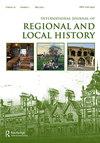Borders, Centres and Peripheries in late Roman and Visigothic Iberia
Q2 Arts and Humanities
International Journal of Regional and Local History
Pub Date : 2015-05-01
DOI:10.1179/2051453015Z.00000000021
引用次数: 1
Abstract
Abstract This article surveys scholarship on the evolving provincial organization of the Iberian Peninsula in the late and immediately post-Roman periods (fourth to early eighth centuries CE), when the region moved gradually from the control of the Western Roman Empire to that of the kingdom of the Visigoths, a “barbarian” group who had gradually integrated themselves into the late Roman order in the fourth and fifth centuries. My analysis of this issue over a long time frame suggests that the internal divisions and external boundaries of the late antique Iberian Peninsula (Roman Hispania) were highly fluid and liable to change in response to economic, military, religious and, above all, political factors. The exact make up of Hispania in this period was largely dependent on an ongoing dialogue – sometimes peaceful, sometimes conflictual – between central sources of authority, whether imperial or royal, and more regionally-based powers.罗马晚期和西哥特伊比利亚的边界、中心和外围
摘要本文综述了伊比利亚半岛在罗马晚期和后罗马时期(公元4世纪至8世纪初)省组织演变的学术研究,当时该地区逐渐从西罗马帝国的控制下转移到西哥特王国的控制下,西哥特人是一个“野蛮人”群体,在公元4世纪和5世纪逐渐融入了罗马晚期的秩序。我对这个问题的长期分析表明,古代晚期伊比利亚半岛(罗马-伊斯帕尼亚)的内部划分和外部边界高度不稳定,容易因经济、军事、宗教和最重要的政治因素而变化。在这一时期,西班牙的确切构成在很大程度上取决于中央权威(无论是帝国的还是皇家的)与更以地区为基础的权力之间的持续对话——有时是和平的,有时是冲突的。
本文章由计算机程序翻译,如有差异,请以英文原文为准。
求助全文
约1分钟内获得全文
求助全文
来源期刊

International Journal of Regional and Local History
Arts and Humanities-History
CiteScore
0.30
自引率
0.00%
发文量
10
期刊介绍:
The International Journal of Regional and Local History aims to publish high-quality academic articles which address the history of regions and localities in the medieval, early-modern and modern eras. Regional and local are defined in broad terms, encouraging their examination in both urban and rural contexts, and as administrative, cultural and geographical entities. Regional histories may transcend both local and national boundaries, and offer a means of interrogating the temporality of such structures. Such histories might broaden understandings arrived at through a national focus or help develop agendas for future exploration. The subject matter of regional and local histories invites a number of methodological approaches including oral history, comparative history, cultural history and history from below. We welcome contributions situated in these methodological frameworks but are also keen to elicit inter-disciplinary work which seeks to understand the history of regions or localities through the methodologies of geography, sociology or cultural studies. The journal also publishes book reviews and review articles on themes relating to regional or local history.
 求助内容:
求助内容: 应助结果提醒方式:
应助结果提醒方式:


